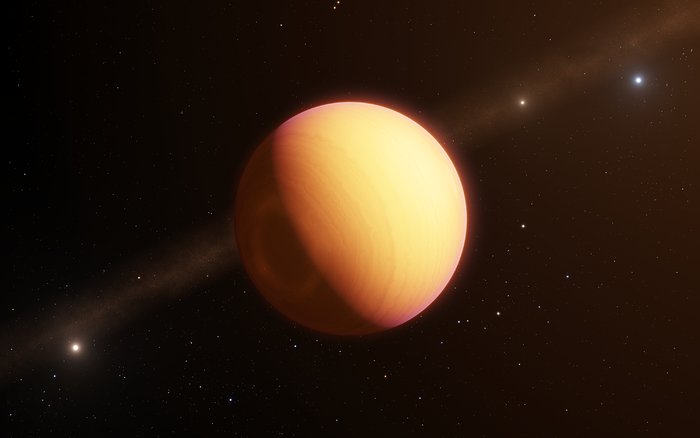The GRAVITY instrument, mounted on ESO's Very Large Telescope (VLTI) Interferometer, obtained its first direct observation of an exoplanet using optical interferometry.
This method revealed a complex exoplanet atmosphere with clouds of iron and silicates within a planet-wide storm. This technique presents unique possibilities for characterizing many of the exoplanets that are currently known.
This result was announced today in a letter to the magazine Astronomy & Astrophysics by the GRAVITY Collaboration, in which observations of the exoplanet HR 8799e using optical interferometry were presented. This exoplanet was discovered in 2010 orbiting a young main sequence star, HR 8799, located about 129 light-years away from Earth in the constellation Pegasus.
Today's results, which reveal new features of the HR 8799e, required an instrument of very high resolution and sensitivity.
O GRAVITY can use the four Main Telescopes of the ESO VLT in unison as if they were a single huge telescope, using a technique known as interferometry. This super-telescope — the VLTI — precisely collects and separates the radiation emitted by the HR 8799e's atmosphere and the radiation emitted by its parent star.
HR 8799e is a super-Jupiter-type exoplanet, a world unlike any other planet in the Solar System, as it is more massive and much younger than any of the planets orbiting our Sun.
Just 30 million years old, this baby exoplanet is young enough to give astronomers clues about the formation of planets and planetary systems.
The exoplanet is completely inhospitable — the energy left over from its formation and a strong greenhouse effect cause HR 8799e to have a surface temperature of around 1000°C.
This is the first time that optical interferometry has been used to reveal details about an exoplanet and the new technique has given us a spectrum extremely detailed with unprecedented quality—ten times more detailed than previous observations.
The measurements carried out by the team revealed the composition of the HR 8799e's atmosphere — which contains some surprises. Interferometry is a technique that allows astronomers to create a super telescope by combining several smaller telescopes.
ESO's VLTI is an interferometric telescope created by combining two or more Very Large Telescope Master Telescopes or four Auxiliary Telescopes of the same infrastructure. Since each Main Telescope has a primary mirror 8,2 meters in diameter, when you combine them, you create a telescope with 25 times more resolving power than if you had a single telescope to observe on its own.
“Our analysis has shown that HR 8799e has an atmosphere that contains much more carbon monoxide than methane — something you would not expect from chemical equilibrium,” explains team leader Sylvestre Lacour, CNRS researcher at the Paris Observatory – PSL and at the Max Planck Institute for Extraterrestrial Physics. "The best way to explain this surprising result is with high vertical winds within the atmosphere, which prevent carbon monoxide from reacting with hydrogen to form methane."
The team found that the atmosphere also contains clouds of iron dust and silicates. When combined with excess carbon monoxide, this suggests that the HR 8799e's atmosphere is suffering from the effects of a massive and violent storm.
“Our observations suggest a ball of gas lit from the inside, with rays of warm light moving in the dark stormy clouds,” explains Lacour.
”Convection moves the clouds of iron particles and silicates, which break down causing rain inside. This scenario shows us a dynamic atmosphere on a newly formed giant exoplanet, where highly complex physical and chemical processes take place”.
This result adds to the already impressive array of discoveries made with the help of GRAVITY, which include the Last year's observation of spiraling gas with a speed of 30% of the speed of light in the region just beyond the event horizon of the supermassive black hole at the Galactic Center.
This new result adds yet another way to observe exoplanets to the already extensive arsenal of methods available to ESO's telescopes and instruments.
Exoplanets have been observed using many different methods. Some of these methods are indirect, such as the radial speed method that is used by the HARP, ESO's exoplanet hunter instrument, which measures the pull a planet's gravity exerts on its parent star.
Direct methods, such as the pioneering technique used to obtain this result, involve observing the planet itself rather than the effect it has on its star.
This new direct method opens new paths to many other impressive discoveries.
Author ESO Portugal
Science in the Regional Press – Ciência Viva



















Comments